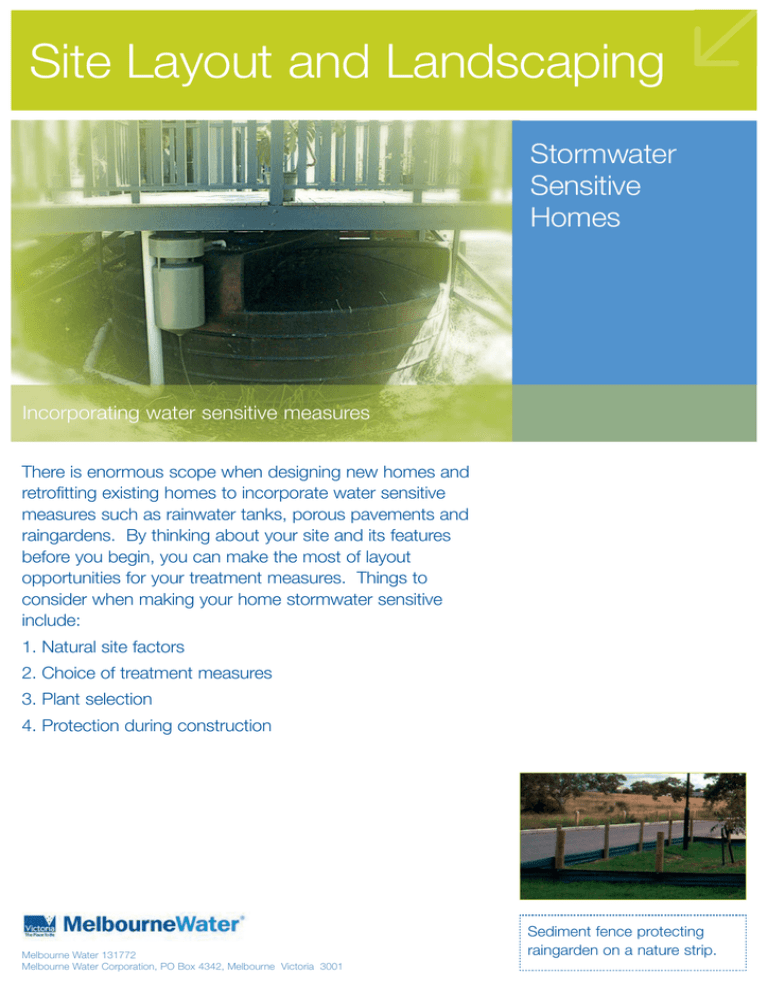Site layout and landscaping guidelines
advertisement

Site Layout and Landscaping Stormwater Sensitive Homes Incorporating water sensitive measures There is enormous scope when designing new homes and retrofitting existing homes to incorporate water sensitive measures such as rainwater tanks, porous pavements and raingardens. By thinking about your site and its features before you begin, you can make the most of layout opportunities for your treatment measures. Things to consider when making your home stormwater sensitive include: 1. Natural site factors 2. Choice of treatment measures 3. Plant selection 4. Protection during construction Melbourne Water 131772 Melbourne Water Corporation, PO Box 4342, Melbourne Victoria 3001 Sediment fence protecting raingarden on a nature strip. Site Layout and Landscaping Stormwater Sensitive Homes What to consider when designing the layout of your stormwater sensitive site 1. Natural site factors 3. Plant selection Understanding your sites topography, rainfall, existing drainage patterns, expected flows, soil, vegetation and sun/shade patterns before you begin can help you plan the layout of your stormwater treatment measures. By understanding and incorporating the natural site features of your site into your design, you can maximize the effectiveness of your treatment measures whilst creating aesthetically pleasing surroundings for your home. A wide variety of plants are suitable for your stormwater treatment measures with characteristics that incorporate the necessary treatment function and your aesthetic preferences. Choice of plants will depend on your visual preferences coupled with their suitability to your sites soil and climatic conditions whilst withstanding periods of soil saturation and anaerobic conditions. Preference should be given to local native species and it is wise to check with your council that the plants you choose are not environmental weeds in your area. 2. Choice of treatment measures Runoff from your block mainly comes from your roof and pavement. Rainwater tanks, raingardens, buffer strips and porous pavements call all be used to treat rainwater runoff. Exactly how your site ultimately looks will depend on your creativity, individual needs and the individual site factors you are working with. There is a lot of scope to be creative in your layout and it is important to remember that you are not constrained by using just one treatment measure. You may choose to collect runoff from your roof and direct it to a raintank to supply water for toilet flushing, or you may choose to direct your roof runoff to a raingarden. You may even choose to do both. By knowing the amount of rain and runoff you receive and where you sun and shady areas are will help you to design the best layout for your stormwater treatments whilst creating the home surroundings you desire. 4. Protection during construction It is important to protect both your stormwater treatment measures and the stormwater drains from excess sediment being washed into them during the construction phase of your site. Without adequate protection during this time, stormwater treatment measures can become clogged with dirt and soil washing from your site. Clogging risks their ability to adequately treat stormwater and it is likely that the clogged treatment measure will will need to be cleaned out. Using sediment fences to capture dirt and soil coming from your site is an easy way to protect your stormwater treatment measures, and your local stream from being smothered by if loads are not captured along the way. Grassed area Porous paving Roof water drain to tank plumbing inside Tank Porous paving Roof draining to rain garden Carport directed to garden area Garden Garden planted with native species Rain garden planter box Garden buffering edge of property Road By considering your site factors before you begin it is possible to create a stormwater sensitive home that suits your individual needs. The figure above shows one possible overall water sensitive strategy for a typical suburban home. A rainwater tank collects half of the roof runoff and is plumbed to supply rainwater for toilet flushing and outdoor use. The remaining roof runoff is directed into a raingarden. Stormwater runoff from paths, driveways and lawns is directed to garden areas. Concrete impervious pavements have been replaced with porous pavements and a buffer garden area is protecting any excess runoff from reaching the road and into the conventional stormwater drainage system. For more information: Melbourne Water’s Water Sensitive Urban Design Website: www.wsud.melbournewater.com.au Urban Stormwater Best Practice Environmental Management Guidelines, Victorian Stormwater Committee, CSIRO publishing, 1999. Municipal Association of Victoria Clearwater Program: www.clearwater.asn.au WSUD Engineering Procedures: Stormwater, Melbourne Water, 2005. Water Sensitive Urban Design in the Sydney Region: www.wsud.org Delivering Water Sensitive Urban Design: Final Report of Clean Stormwater – a planning framework, ABM, 2004.








